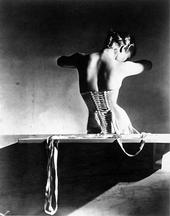HORST
b. August 14, 1906,
Weißenfels-an-der-Saale, Germany
d.
November
18, 1999, Palm Beach Gardens, Florida
Horst P. Horst, born Horst Paul Albert Bohrmann, and most often known as just Horst was a photographer best known for his photographs of women and fashion taken while working for Vogue.
CHILDHOOD
Horst was born in Weißenfels-an-der-Saale, Germany, to Klara (Schönbrodt) and Max Bohrmann. His father was a successful merchant. In his teens, he met dancer Eva Weidemann at the home of his aunt's, and this aroused his interest in avant-garde art. In the late 1920s, Horst studied at Hamburg Kunstgewerbeschule, leaving there to go to Paris to study under the architect Le Corbusier.
YOUTH
While in Paris, he befriended many people in the art community and attended many galleries. In 1930 he met Vogue photographer Baron George Hoyningen-Huene, a half-Baltic, half-American nobleman, and became his lover. He traveled to England with him that winter. While there, they visited photographer Cecil Beaton, who was working for the British edition of Vogue. In 1931, Horst began his association with Vogue, publishing his first photograph in the French edition of Vogue in November of that year.
His first exhibition was hung in La Plume d'Or in Paris in 1932. It was reviewed by Janet Flanner in The New Yorker, and this review, which appeared after his exhibit was over, made Horst instantly famous. Horst made a portrait of Bette Davis the same year, the first in a series of celebrities he would photograph during his life. Within two years, he had photographed Noel Coward, Yvonne Printemps, Lisa Fonssagrives, Natasha Paley, Cole Porter, Elsa Schiaparelli, and others. Horst rented an apartment in New York in 1937, and while residing there met Coco Chanel Chanel, whom Horst called 'the queen of the whole thing.' He would photograph her fashions for three decades.He met Valentine Lawford, British diplomat in 1938 and they would live together as a couple until Horst's death. They adopted and raised a son, Richard J. Horst, together.In 1940, Horst applied for United States citizenship. In 1942 he passed an Army physical, and joined the Army on July 2, 1943. On October 21 he received his United States citizenship as Horst P. Horst. He became an Army photographer, with much of his work printed in the forces' magazine Belvoir Castle. In 1945 he photographed United States President Harry S. Truman, with whom he became friends, and he photographed every First Lady in the post-war period at the invitation of the White House. In 1947, Horst moved into his house in Oyster Bay, New York. He designed the white stucco-clad building himself, the design inspired by the houses that he had seen in Tunisia during his relationship with Hoyningen-Huene.
WORK Horst is best known for his photographs of women and fashion, but is also recognized for his photographs of interior architecture, still lifes, especially ones including plants, and environmental portraits. One of the great iconic photos of the Twentieth-Century is "The Mainbocher Corset" with its erotically charged mystery, captured by Horst in VOGUE’s Paris studio in 1939. Designers like Donna Karen continue to use the timeless beauty of "The Mainbocher Corset" as an inspiration for their outerwear collections today. His work frequently reflects his interest in Surrealism and his regard of the ancient Greek ideal of physical beauty.His method of work typically entailed careful preparation for the shoot, with the lighting and studio props (of which he used many) arranged in advance. His instructions to models are remembered as being brief and to the point. His published work uses lighting to pick out the subject; he frequently used four spotlights, often one of them pointing down from the ceiling. Only rarely do his photos include shadows falling on the background of the set. Horst rarely, if ever, used filters. While most of his work is in black & white, much of his color photography includes largely monochromatic settings to set off a colorful fashion. Horst's color photography did include documentation of society interior design, well noted in the volume "Horst Interiors." He photographed a number of interiors designed by Robert Denning and Vincent Fourcade of Denning & Fourcade and often visited their homes on Manhattan and Long Island. After making the photograph, Horst generally left it up to others to develop, print, crop, and edit his work.One of his most famous portraits is of Marlene Dietrich, taken in 1942. She protested the lighting that he had selected and arranged, but he used it anyway. Dietrich liked the results and subsequently used a photo from the session in her own publicity.
LATER LIFEIn the 1960s, encouraged by Vogue editor Diana Vreeland, Horst began a series of photos illustrating the lifestyle of international high society. The articles were written by the photographer's longtime companion, Valentine Lawford, a former English diplomat. From this point until nearly the time of his death, Horst spent most of his time traveling and photographing. In the mid 1970s, he began working for House & Garden magazine as well as for Vogue. He died at his home in Palm Beach Gardens, Florida, at 93 years of age.
